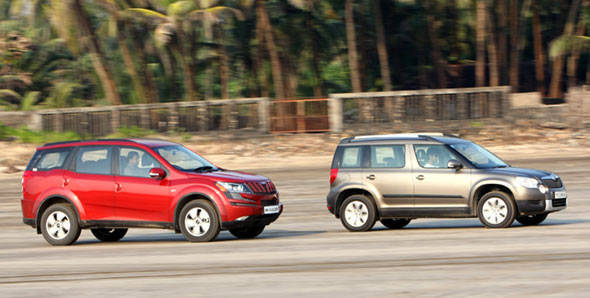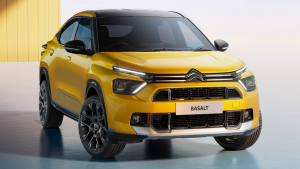Mahindra XUV500 vs Skoda Yeti

Now the Skoda Yeti 4x4 in India is no stranger to us at OVERDRIVE. Having been part of our long term fleet for several months now, we have grown quite fond of this gentle monster. Like the XUV, the Yeti too is built on a monocoque chassis, the platform shared with the Laura. This makes the Yeti a breeze to drive, thoroughly car-like and thus scoring over the XUV. The XUV500 in India remains the bulkier of the two and is not quite as easy as the Yeti to manoeuvre through city traffic. However, this size advantage can also be a disadvantage. Not many people who buy an SUV buy it for its compact nature. They usually want SUVs to possess immense road presence. This is where the Yeti's compact dimensions lose out. For the Rs 16.33 lakh price tag (ex-showroom Mumbai) the Yeti does not look like a lot of SUV. The XUV on the other hand is sure to intimidate more than the rather meek looking Skoda, it's a lot of metal for much less.
One advantage that the Yeti comes with is that the Skoda's drive is channelled to all four wheels all the time while the XUV makes do with a regular FWD drivetrain. This means that once off the road, the XUV will be left behind by the surprisingly capable Yeti, the compact proportions and short overhangs aiding immensely (even though at 180mm its ground clearance is 20mm less than the XUV). The Yeti has just landed another jab to the XUV then.
It's not just off-road that the Yeti scores over the XUV. In terms of on road dynamics, the Haldex 4WD system comes into play using predetermined patterns to reduce understeer or oversteer situations by redistributing torque between left or rear wheels, there is just not enough praise that can be given for the Yeti and the way it feels on tarmac. The Yeti feels more planted and confident going around corners with minimal amounts of body roll. Yet another aspect that puts the Yeti ahead of the XUV is its steering which is much more precise, better balanced and far more progressive. The XUV, as you've read before, is way better than anything Mahindra have ever built before, yet it's still several rungs below the Yeti. There is a fair amount of understeer, the steering does not feel as progressive or communicative and the taller stance means body roll is more pronounced. The brakes on the Yeti are far better with powerful and enormous bite reducing speeds with more authority. The XUV tends to squeal a lot going around corners or while braking hard with some amount of fade and grind.
Talk about interior space and the XUV is far ahead in the game. At 4585mm, the XUV is almost 350mm longer than the Skoda (4223mm), which directly translates into more space. The main drawback in the Yeti is that it does not have a third row of seating. But then, third row seating is not something that even the biggest of SUVs have got right with most third rows being impractical. The Yeti might lack a third row of seats, but its modular seats can be rearranged to seat two, three, four or five people by merely folding or removing any one, two or all three of the rear seats. All it takes is simple snap of a lever to completely remove a seat from the rear and increase boot space to a gigantic 1760 litres with the second row removed.
Yet the XUV seats fold down flat offering better load area (up to 1512 litres with both rows folded) while the Yeti is never entirely with the seats folded and if you had to take the seats out the only place to leave them is home, not the most practical solution is it?
Step inside the Yeti and instantly you feel like you're inside a car rather than an SUV. Talking about being well put together, the Yeti's interiors feel much more high quality than the XUV. Where the XUV beats the Skoda by miles is in terms of the amount of features it has. With features such as an easy to operate satnav, the XUV leaps ahead and disappears over the horizon. In comparison the Yeti's cabin feels minimalistic and plain. Even though both cars have touch screen infotainment systems, the XUV wins in terms of the sheer number of goodies it has within that infotainment system, leave aside the other stuff it has such as the conversation mirror or the various mood lights in the cabin.
The XUV's contoured seats feel like you're being enveloped by luxury from all sides while the Yeti feels like any other Skoda (not that they're bad in any way). The chocolate coloured interiors make the XUV seem a step ahead of the plain looking Yeti. In terms of build quality however, the Skoda is far ahead of the Mahindra. No rough edges will be found in this cabin.
Under the hood, both cars make almost the same power with the Skoda's 2.0-litre mill making 141PS of power and 320Nm of torque, only 1PS more than the XUV with matching torque figures. Cabin noise levels however are vastly different, the Yeti's engine is way quieter and operates far more smoothly than its Indian counterpart. The Skoda's diesel engine revs much faster than usual too while the XUV has a typical slow revving engine. The XUV's gearbox takes a lot more effort to operate unlike the Yeti's slick 6-speed number which partly explains the higher refinement, lesser vibes and better performance. The combination of all this propels the Yeti to 100kmph in just 10.43 seconds. That's 2.43 seconds faster than what the XUV manages. However this comes at the price of efficiency. Where the XUV gives an overall efficiency of 12.78kmpl, the Yeti gives only 10.62kmpl.
The Yeti is pure mercenary, a gun for hire to the highest bidder. It trounces the XUV with cold efficiency, but this ability comes at a rather steep price, nearly Rs 3.5 lakh more than the XUV. The Skoda Yeti price in India is Rs 14.98 lakh for the base variant with most high end luxury trappings absent. In comparison, the top-end XUV500 W8 price in India is Rs 11.88 lakh and comes packed with a lot more goodies than your average Christmas tree after St. Nicholas comes calling. It's why the XUV makes more sense but after driving the two there's no doubt it will be Yeti you will aspire to own.
Starts Rs 12.23 Lakhs
2179cc
Automatic
140
320
-NA-











